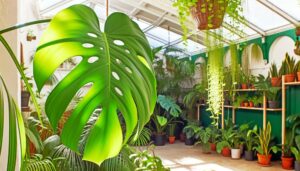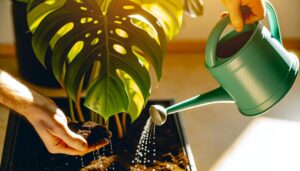What Is a Monstera Plant? An Introduction and Overview!
Monstera deliciosa, an enchanting member of the Araceae family, hails from Central America’s tropical rainforests. You’ll adore its large, fenestrated leaves and climbing, epiphytic nature.
Popular species include Monstera adansonii and Monstera obliqua. For ideal growth, provide bright, indirect light, high humidity (60-80%), and well-draining, peat-based soil enriched with perlite or orchid bark.
Water it once the top inch of soil dries out. Watch for pests like spider mites and mealybugs, and choose propagation methods like stem cuttings or air layering.
With these insights, you’re now poised to discover more fascinating details about Monstera plants.
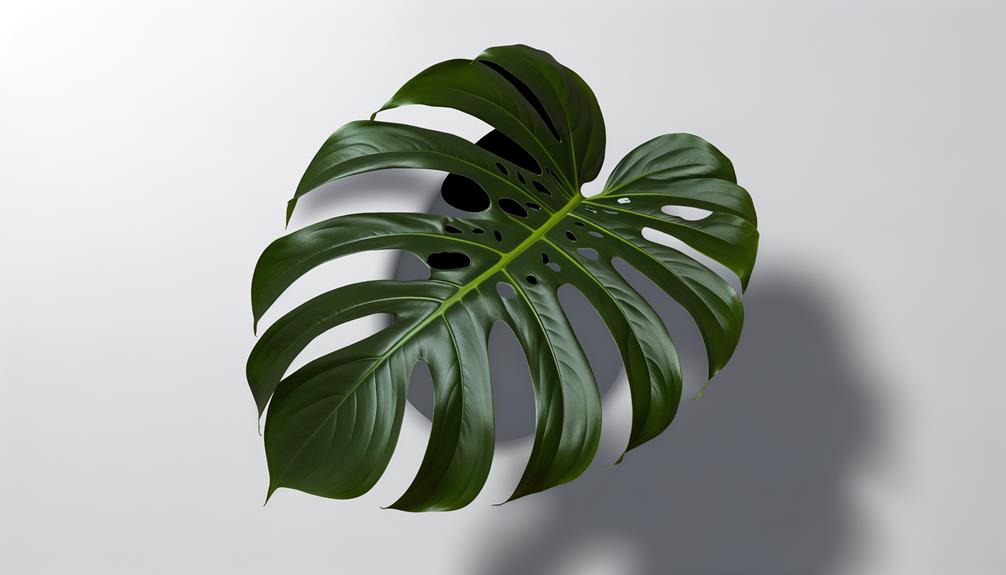
Key Takeaways
- Monstera plants are tropical rainforest natives from Central America, belonging to the Araceae family.
- They are known for their unique, fenestrated leaves with natural splits and holes.
- Popular varieties include Monstera deliciosa, Monstera adansonii, and Monstera obliqua.
- Monsteras thrive in indirect sunlight, high humidity, and well-draining soil.
- These plants enhance indoor aesthetics and act as natural air purifiers by filtering pollutants.
Monstera Plant Origins

The Monstera plant, scientifically known as Monstera deliciosa, originates from the tropical rainforests of Central America, particularly southern Mexico and Panama. You’ll find these plants thriving in humid, dense forests with rich, well-drained soil. They belong to the Araceae family and prefer shaded environments, often growing under the canopy of taller trees.
In their natural habitat, Monsteras exhibit epiphytic behavior, meaning they attach to other plants for support. This climbing habit allows them to reach sunlight while minimizing root competition. Monstera deliciosa plants also exhibit impressive adaptability, surviving in diverse altitudes and climates within their native range.
Understanding their origins helps you appreciate the environmental conditions required to cultivate these plants successfully in non-native regions.
Unique Leaf Structure
You’ll notice the Monstera deliciosa‘s unique leaf structure characterized by natural fenestrations, which are splits and holes that develop as the leaf matures.
These fenestrations aren’t random but are an adaptive evolution, allowing light to filter through the canopy, mimicking the dappled light conditions of tropical forests.
This structural adaptation also reduces wind resistance, contributing to the plant’s survival in its native habitat.
Natural Leaf Fenestrations
Monstera deliciosa exhibits natural leaf fenestrations, characterized by holes and splits that increase photosynthetic efficiency and minimize damage from wind. These fenestrations are not just visually distinctive; they offer functional advantages.
By allowing light to pass through to lower leaves, Monstera maximizes photosynthesis. Additionally, the splits reduce wind resistance, preventing tears.
Here’s a breakdown of the unique features:
| Feature | Description | Function |
|---|---|---|
| Holes | Circular openings in the leaf blade | Light penetration to lower foliage |
| Splits | Elongated cuts along the leaf edge | Wind resistance reduction |
| Leaf Size | Large, up to 90 cm | Maximizes surface area for photosynthesis |
| Texture | Glossy and leathery | Reduces water loss through evaporation |
| Color | Dark green | Ideal for capturing sunlight |
Understanding these features helps you appreciate the Monstera’s adaptability and resilience.
Split and Hole Formation
Understanding the formation of splits and holes in Monstera deliciosa involves examining the plant’s unique developmental processes and genetic predispositions.
The characteristic fenestrations, or perforations, begin as the leaf matures. The process starts at the base of the leaf, where cells undergo programmed cell death, scientifically known as apoptosis, creating the initial holes. As the leaf expands, these holes elongate and form distinct splits, resulting in the iconic lobed and perforated appearance.
The genetic expression of these traits is influenced by environmental factors such as light intensity and humidity. The specific patterns of fenestration are unique to each leaf, dictated by the plant’s genome, ensuring its leaves’ best structure and function for its growth habitat.
Adaptive Leaf Evolution
Within the context of adaptive leaf evolution, the unique structure of Monstera deliciosa leaves maximizes photosynthetic efficiency while reducing water loss through intricate fenestrations and lobes.
These fenestrations, or natural perforations, allow light to penetrate deeper into the canopy, optimizing light absorption for lower leaves.
The lobes reduce wind resistance and water loss by minimizing the leaf surface area exposed to the sun and air. Additionally, the irregular shape helps the leaves withstand tropical downpours by allowing rainwater to pass through, preventing damage.
The combination of these features enhances the plant’s overall resilience in its native rainforest habitat.
Varieties of Monstera
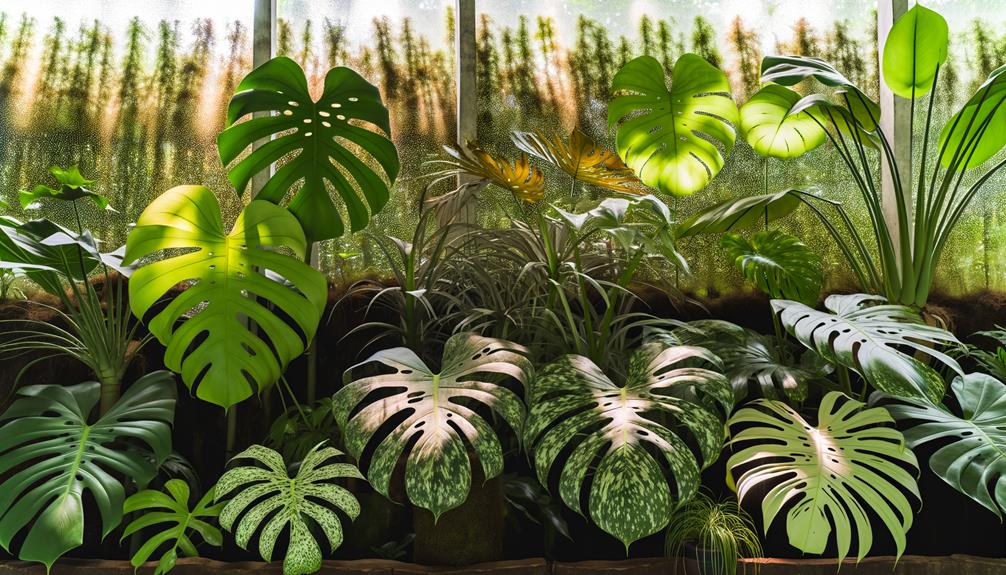
When exploring the varieties of Monstera, you’ll encounter popular types such as Monstera deliciosa, Monstera adansonii, and Monstera obliqua.
Each species exhibits unique leaf characteristics; for instance, Monstera deliciosa features large, fenestrated leaves, while Monstera adansonii has smaller, perforated foliage.
Understanding these differences will help you identify and care for these distinct species.
Popular Monstera Types
Among the most sought-after varieties, Monstera deliciosa, Monstera adansonii, and Monstera obliqua each exhibit unique leaf patterns and growth habits that distinguish them from one another.
Monstera deliciosa, commonly known as the Swiss Cheese Plant, features large, fenestrated leaves and robust growth.
Monstera adansonii, or the Swiss Cheese Vine, showcases smaller, perforated leaves and a trailing growth habit, making it ideal for hanging baskets.
Monstera obliqua, known for its delicate and highly perforated leaves, is rare and requires precise humidity and temperature conditions for peak growth. Each species belongs to the Araceae family and thrives in tropical environments.
Understanding the specific care requirements and natural habitats of these varieties helps promote healthy and vibrant plants.
Unique Leaf Characteristics
Exploring the distinctive leaf features of Monstera varieties reveals intricate patterns and structures that are both fascinating and functionally significant. The fenestrations or natural holes in Monstera deliciosa leaves, for example, enhance light penetration and reduce wind resistance.
Monstera adansonii, recognized for its smaller, oval perforations, offers a delicate appearance. Monstera obliqua showcases even more striking leaf perforations, often consisting of more hole than leaf.
| Monstera Species | Unique Leaf Characteristic |
|---|---|
| Monstera deliciosa | Large, deep fenestrations |
| Monstera adansonii | Smaller, oval-shaped perforations |
| Monstera obliqua | Extensive perforations, more hole than leaf |
Understanding these leaf traits not only enhances your appreciation but also informs proper care techniques, ensuring ideal growth and health for these enthralling plants.
Ideal Growing Conditions
To flourish, Monstera deliciosa requires a combination of indirect sunlight, high humidity, and well-draining soil rich in organic matter. Provide bright, indirect light to prevent leaf burn while ensuring the plant receives sufficient energy for photosynthesis.
Maintain humidity levels between 60% to 80% to mimic the tropical environment of its native habitat, ensuring best growth. Utilize a well-aerated, peat-based potting mix to facilitate proper drainage and nutrient retention. Incorporate perlite or orchid bark to improve soil aeration.
The ideal temperature range is 65°F to 85°F (18°C to 29°C). Avoid placing the plant in drafts or near heating vents, as temperature fluctuations can stress the plant. Proper growing conditions will promote healthy foliage and encourage the development of fenestrations.
Watering Needs
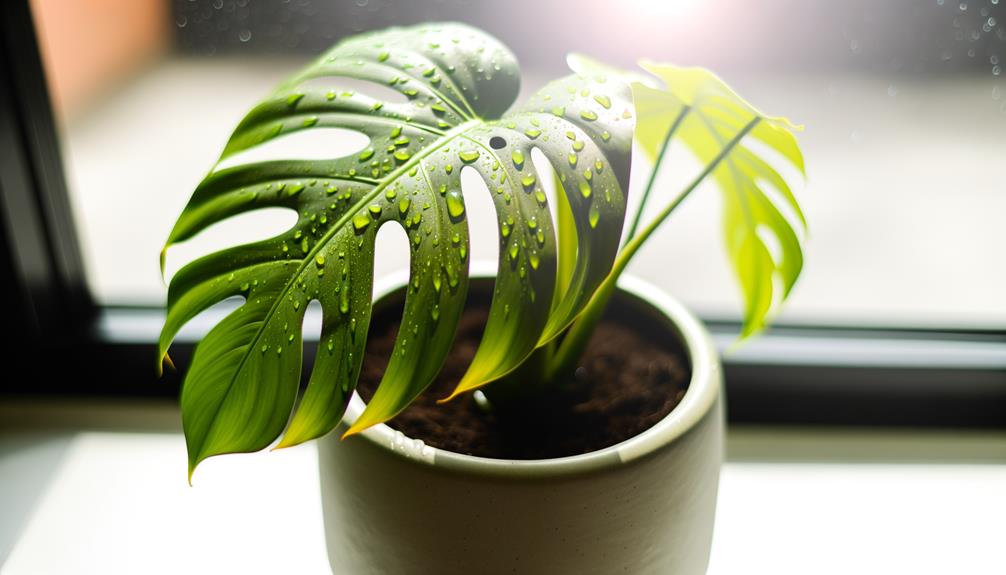
When caring for your Monstera deliciosa, you should monitor watering frequency to maintain ideal soil moisture levels.
It’s important to allow the top inch of the substrate to dry out between waterings to prevent root rot.
Watch for signs of overwatering, such as yellowing leaves and a musty scent coming from the soil.
Frequency of Watering
Ensuring that your Monstera deliciosa receives the appropriate amount of water is essential for its health and growth. You should water your Monstera once the top 2-3 inches of soil are dry.
During the growing season (spring and summer), you may need to water more frequently, approximately once a week. In the dormant period (autumn and winter), reduce the frequency to every 2-3 weeks. Over-watering can lead to root rot in Monstera deliciosa.
| Season | Watering Frequency | Soil Dryness Indicator |
|---|---|---|
| Spring/Summer | Once a week | Top 2-3 inches dry |
| Autumn/Winter | Every 2-3 weeks | Top 3 inches dry |
| Year-round | Adjust as necessary | Monitor soil consistently |
Always use well-draining soil to prevent waterlogging.
Soil Moisture Levels
Monitoring soil moisture levels is essential for maintaining the ideal watering needs of your Monstera deliciosa. Use a moisture meter to confirm the soil’s moisture content remains between 40-60%. Insert the probe into the root zone, avoiding over-saturation.
The substrate should be well-draining, consisting of a mix of peat, perlite, and pine bark. Aim to keep the top 2 inches of soil dry before re-watering.
Overly wet conditions can lead to root rot (Rhizoctonia solani infection), while dry soil stresses the plant, hindering growth. Regularly check soil moisture to prevent these issues. For accuracy, measure moisture at multiple points in the pot.
This vigilance confirms your Monstera thrives, displaying its iconic fenestrated leaves.
Signs of Overwatering
Overwatering your Monstera deliciosa is evidenced by various signs. These include yellowing leaves, soggy stems, and a damp smell coming from the soil. Chlorosis, or leaf yellowing, indicates roots saturated with water, leading to a lack of oxygen.
Check the stems. If they feel mushy or soft, Pythium or Phytophthora root rot may be present. The damp smell indicates anaerobic conditions in the soil, encouraging fungal growth.
Lift the plant from its container and examine the roots. Healthy roots are white and sturdy, while overwatered roots look brown and slippery. Make sure your pot has sufficient drainage holes, and allow the top few inches of soil to dry between waterings. Using a moisture meter can assist in maintaining ideal hydration levels for your Monstera deliciosa.
Soil Requirements
For best growth, Monstera deliciosa requires well-draining soil rich in organic matter to prevent root rot and support its aerial roots. You should aim for a soil mix that mimics its natural tropical habitat.
Consider incorporating the following components:
- Peat Moss: Enhances moisture retention while maintaining aeration.
- Perlite: Improves drainage and prevents soil compaction.
- Orchid Bark: Provides a chunky texture, promoting air circulation around the roots.
- Compost: Supplies essential nutrients and fosters beneficial microbial activity.
These components create a balanced environment, allowing the roots to breathe and absorb nutrients efficiently.
Avoid dense, clay-based soils as they can lead to waterlogging and root diseases.
Regularly monitor the soil’s moisture levels, ensuring it remains slightly damp but not waterlogged.
Light Preferences
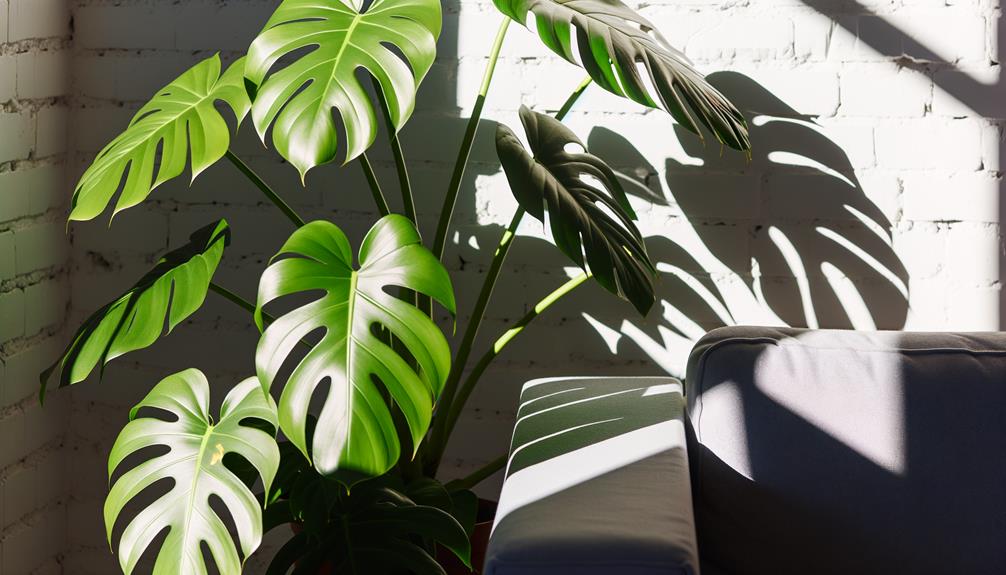
To flourish, Monstera deliciosa needs bright, indirect sunlight, mimicking the speckled sunlight of its native tropical understory habitat. Place your Monstera close to east or south-facing windows, guaranteeing it isn’t exposed to direct sunlight, which might damage its leaves. The optimal light level ranges from 10,000 to 20,000 lux.
Inadequate light results in etiolation, leading to stretched, feeble stems and smaller leaves without the distinctive fenestrations.
Conversely, excessive light may cause chlorosis or sunburn, appearing as yellowing or brown spots. If natural light isn’t enough, you can add full-spectrum fluorescent or LED grow lights, keeping a distance of 12-24 inches to prevent overheating.
Regularly rotate the plant to secure uniform light distribution and well-balanced growth.
Common Pests
Identifying common pests like spider mites (Tetranychus urticae), mealybugs (Pseudococcidae family), and scale insects (Coccoidea superfamily) is essential for maintaining your Monstera plant’s health. These pests can cause significant damage by feeding on plant sap, leading to yellowing leaves, stunted growth, and decreased vigor.
To effectively manage these pests, you should:
- Regularly inspect the underside of leaves where spider mites often congregate.
- Isolate affected plants to prevent the spread of mealybugs, which appear as cotton-like masses.
- Utilize horticultural oils or insecticidal soaps to control scale insects that form protective shells.
- Maintain high humidity levels to deter spider mites, which thrive in dry conditions.
Propagation Techniques
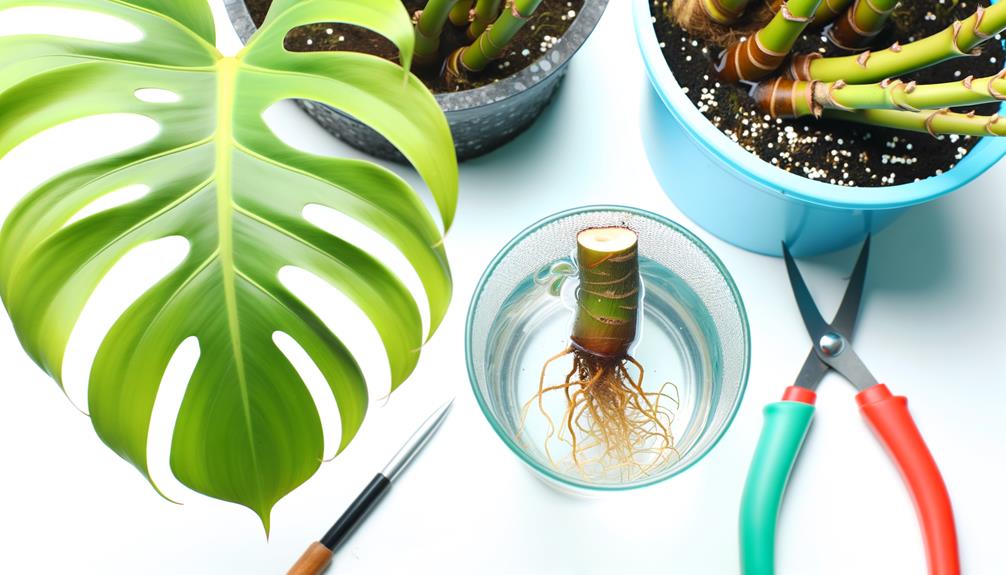
Successfully propagating your Monstera deliciosa can be achieved through stem cuttings, air layering, or division, each method offering distinct advantages. Stem cuttings involve snipping a segment just below a node, ensuring the presence of aerial roots.
For air layering, you’ll need to create a small wound on a stem, wrap it with moist sphagnum moss, and enclose it in plastic until roots develop. Division is suitable for mature plants with multiple stems; simply separate the root clumps and replant.
Here’s a comparative table:
| Propagation Method | Difficulty Level | Root Formation Time |
|---|---|---|
| Stem Cuttings | Easy | 3-4 weeks |
| Air Layering | Moderate | 4-6 weeks |
| Division | Moderate | Immediate |
Using these techniques, you can expand your Monstera collection efficiently.
Benefits of Monstera
A Monstera deliciosa, with its distinctive fenestrated leaves, not only enhances indoor aesthetics but also contributes to improved air quality by filtering pollutants. The plant’s large, glossy leaves increase humidity through transpiration, benefiting respiratory health.
Additionally, it can absorb airborne toxins such as formaldehyde, benzene, and trichloroethylene, acting as a natural air purifier.
Here are some specific benefits:
- Air Purification: Monstera removes harmful chemicals from indoor air.
- Humidity Regulation: Increases moisture levels, aiding in respiratory comfort.
- Aesthetic Appeal: Its unique leaf pattern adds visual interest and a tropical vibe.
- Well-being Boost: Presence of greenery can enhance mood and reduce stress.
Troubleshooting Issues
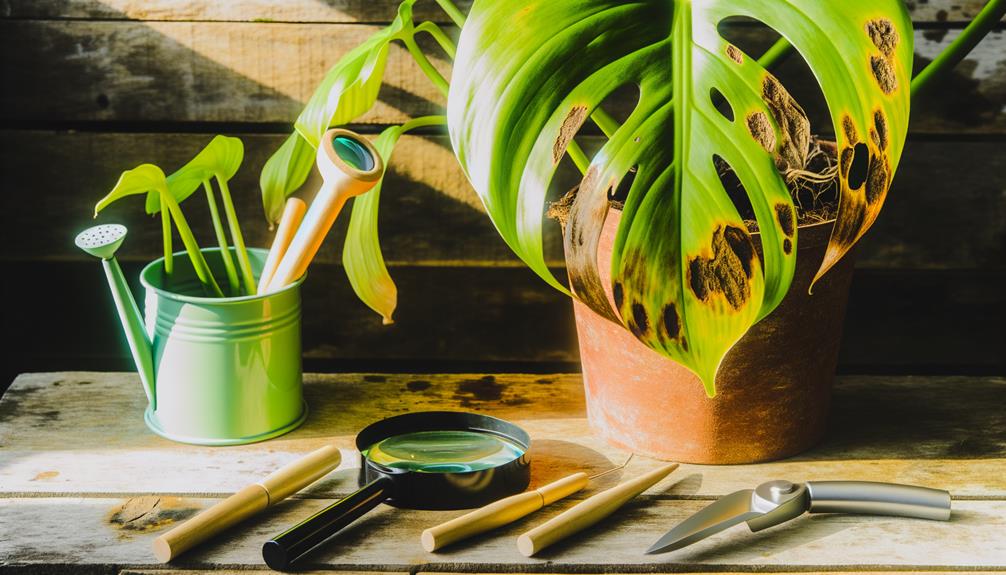
When caring for Monstera deliciosa, you’ll often encounter issues like yellowing leaves, root decay, and pest infestations, which can hinder the plant’s health and growth.
Yellowing leaves commonly result from overwatering or nutrient deficiencies. Make sure that Monstera’s soil has proper drainage and consider using a balanced fertilizer.
Root decay, caused by waterlogged soil, can be identified by mushy roots and a foul odor. Remove affected roots and repot in fresh, well-draining soil.
Pest infestations, such as spider mites (Tetranychus urticae) and scale insects (Coccoidea), require immediate attention. Use insecticidal soap or neem oil to treat infestations.
Regularly inspect your plant and maintain best humidity levels to prevent future issues.
Conclusion
In your home, the Monstera deliciosa thrives, its fenestrated leaves creating a lush, tropical canopy. Picture the glossy, heart-shaped foliage, with unique perforations that dance in sunlight.
Maintaining this plant means understanding specific needs; from ensuring indirect light and high humidity to warding off pests like spider mites.
With proper care, your Monstera will grow robust, its aerial roots anchoring it as a centerpiece of botanical beauty.
Nurture it, and it rewards you with verdant splendor.

